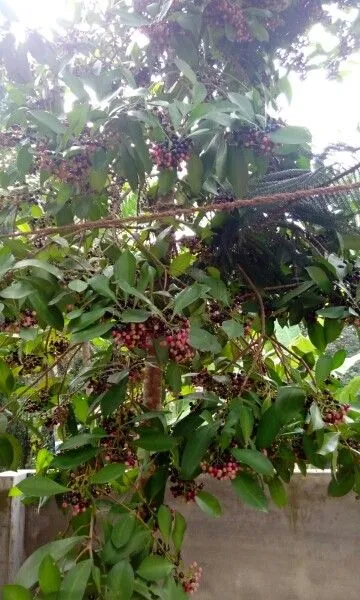
Author: (L.) Skeels
Bibliography: Bull. Bur. Pl. Industr. U.S.D.A. 248: 25 (1912)
Year: 1912
Status: accepted
Rank: species
Genus: Syzygium
Vegetable: False
Observations: Trop. & Subtrop. Asia to N. Queensland
Jambolan, known scientifically as Syzygium cumini, is a notable evergreen tree that’s native to tropical and subtropical regions extending from Asia to Northern Queensland. Borrowing its name from the French botanist Louis-Marie Aubert du Petit-Thouars, Jambolan has been a subject of study and admiration since antiquity due to its hardiness and fruitful yields.
Historically cataloged in the Bulletin of the Bureau of Plant Industry under the United States Department of Agriculture in 1912, the enduring relevance of Jambolan is attributable to its rich heritage and ecological versatility. As a member of the Myrtaceae family, this plant shares a close botanical kinship with other aromatic and medicinal trees and shrubs, and it is celebrated for the bounty it offers.
Jambolan trees are characterized by their sturdy, broad trunks and dense foliage, bearing shiny, dark green leaves that provide a lush canopy. They thrive in humid climates and are often seen decorating landscapes with their striking presence. Blooming between March and April, the tree produces clusters of small, fragrant white flowers that give way to an abundant harvest of fruits, typically ripening from June to September.
The berries that Jambolan trees produce are oblong and range from dark purple to nearly black when mature. These fruits are not only integral to various culinary traditions but are also prized for their nutritional and medicinal properties. Rich in vitamin C, iron, and numerous antioxidants, Jambolan berries are consumed fresh, preserved, or processed into juices, jams, and traditional remedies. The astringent nature of the fruit has been utilized in Ayurvedic practices to manage ailments such as diabetes, indigestion, and inflammation.
Moreover, different parts of the Syzygium cumini, including the bark and leaves, possess significant therapeutic potential. The bark has astringent qualities, making it useful in the treatment of wounds and ulcers, while the leaves are known for their anti-inflammatory and antibacterial properties.
In cultivating Jambolan, minimal intervention is required, as the tree is remarkably resilient and adapts well to different soil types, achieving optimal growth in well-drained loamy soils. However, its preference for full sun exposure helps maximize its fruit production and overall health. Regular irrigation during dry spells ensures that the tree remains lush and productive.
Jambolan plays a crucial role not only in ecosystems but also in the cultural and social fabrics of the communities it thrives in. Its lush greenery, shade-providing canopy, and abundant, health-promoting fruits mark the Jambolan as a botanical gem deserving of recognition and preservation.
Deu: jambolanapflaume, rosenapfel, wachsjambuse
Eng: java plum, java-plum, malabar-plum, portuguese-plum, jambolan, rose-apple, black plum
Spa: uvita, guayabo pesgua, yambolana
Por: azeitona-doce, cereja, jambolão, jamelão
Ita: iambul
Fra: jambolanier, jamelongier, jamélongue
Swe: jambolanäpple
Khm: ព្រីង, ព្រីងដោះក្របី
En: Jambolan, Rose-apple, Malabar-plum, Portuguese-plum, Java-plum, Java plum, Jambolan-Plum, Dhuwâ’, Juwet, जामुन, Black Plum, Indian Blackberry, Jaman, Jambolian, Jambul, Jambolan plum, Kavika ni India
Ar: شجرة البامبوزيا
Bn: জাম
Zh: 堇寶蓮, 阎浮树
Cs: Hřebíčkovec šabrejový
Dv: ދަނބު
Nl: Jambolan
Fi: Jaavanjambolaani
Fr: Jamélongue, Jambolanier, Jamelongier, Jamelonier, Faux-pistachier, Jamelonguier, Jamblon
De: Rosenapfel, Wachsjambuse, Jambolanapflaume, Jambolana-Pflaumenbaum
Gu: જાંબુ (વૃક્ષ)
He: ימבולנה
Hi: Jaman, जामुन
Id: Jamblang
It: Iambul
Jv: Dhuwet
Kn: ನೇರಳೆ
Km: ព្រីង, ព្រីងដោះក្របី
Kv: Джамболан
Ko: 염부나무
Ms: Pokok Jambu keling
Ml: ഞാവൽ
Mr: जांभूळ
Ne: जामुन
Or: ଜାମୁ କୋଳି
Pa: ਜਾਮਣ
Ps: جامنو
Fa: جمبو
Pl: Czapetka kuminowa
Pt: Jambolão, Jamelão, Azeitona-doce, Cereja
Ru: Джамболан
Sa: जम्बूफलम्
Sd: ڄمون
Si: මාදං
Es: Guayabo pesgua, Yambolana, Uvita
Su: Jamblang
Sv: Jambolanäpple
Tl: Duhat
Zh-tw: 堇寶蓮
Ta: நாவல்
Te: నేరేడు
Th: หว้า
Zh-hant: 閻浮樹
Uk: Джамболан
Ur: جامن
Vi: Trâm mốc
Taken May 18, 2021 by Manjunath Megalamani (cc-by-sa)
Taken Jul 4, 2021 by Kunal Turakhia (cc-by-sa)
Taken Mar 9, 2018 by Hugo SANTACREU (cc-by-sa)
Taken Aug 13, 2017 by Hugo SANTACREU (cc-by-sa)
Taken Nov 30, 2022 by Ronaldo Sousa (cc-by-sa)
Taken Apr 3, 2019 by William Correa (cc-by-sa)
Taken Nov 6, 2016 by Sindhu Babussmc (cc-by-sa)
Taken Dec 14, 2021 by gioacchino trapani (cc-by-sa)
Taken Aug 13, 2017 by Hugo SANTACREU (cc-by-sa)
Taken Jul 9, 2022 by Sujan Kumar khatri (cc-by-sa)
© copyright of the Board of Trustees of the Royal Botanic Gardens, Kew.
© copyright of the Board of Trustees of the Royal Botanic Gardens, Kew.
© copyright of the Board of Trustees of the Royal Botanic Gardens, Kew.
Taken Dec 27, 2019 by valderrama ivan (cc-by-sa)
Taken Mar 28, 2021 by Praveena Rai (cc-by-sa)
Taken Apr 10, 2022 by beurnie mainlow (cc-by-sa)
Taken Jan 3, 2022 by Makoto Makoto (cc-by-sa)
Taken Jul 15, 2021 by JK Ishere (cc-by-sa)
Taken Mar 9, 2018 by Hugo SANTACREU (cc-by-sa)
Taken Nov 29, 2020 by dominoel dominoel (cc-by-sa)
Taken Nov 4, 2021 by Sandra Galbraith (cc-by-sa)
Taken Mar 9, 2018 by Hugo SANTACREU (cc-by-sa)
Taken Mar 9, 2018 by Hugo SANTACREU (cc-by-sa)
Taken Nov 30, 2012 by E. Mouysset (cc-by-sa)
Taken Dec 1, 2020 by Pacheco Bruna (cc-by-sa)
Taken Apr 8, 2015 by Tela Botanica − Hugo SANTACREU (cc-by-sa)
Taken Sep 10, 2021 by Mahesh Ahake (cc-by-sa)
Taken Oct 11, 2020 by shubham tyagi (cc-by-sa)
Taken Nov 13, 2021 by Alberto D’São Pedro (cc-by-sa)
Taken Oct 10, 2020 by katia goudkova (cc-by-sa)
Growth form>: Single Stem
Growth habit>: Tree
Growth rate>: Rapid
Ph maximum: 7.0
Ph minimum: 5.0
Family: Myrtaceae Author: (F.Muell.) K.D.Hill & L.A.S.Johnson Bibliography: Telopea 6: 402 (1995) Year: 1995 Status:…
Family: Rubiaceae Author: Pierre ex A.Froehner Bibliography: Notizbl. Bot. Gart. Berlin-Dahlem 1: 237 (1897) Year:…
Family: Sapindaceae Author: Koidz. Bibliography: J. Coll. Sci. Imp. Univ. Tokyo 32(1): 38 (1911) Year:…
Family: Asteraceae Author: A.Gray Bibliography: Pacif. Railr. Rep.: 107 (1857) Year: 1857 Status: accepted Rank:…
Family: Fabaceae Author: Medik. Bibliography: Vorles. Churpfälz. Phys.-Ökon. Ges. 2: 398 (1787) Year: 1787 Status:…
Family: Aspleniaceae Author: (Cav.) Alston Bibliography: Bull. Misc. Inform. Kew 1932: 309 (1932) Year: 1932…